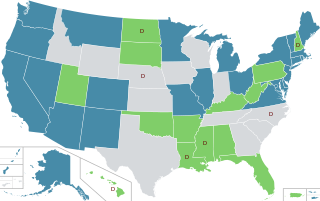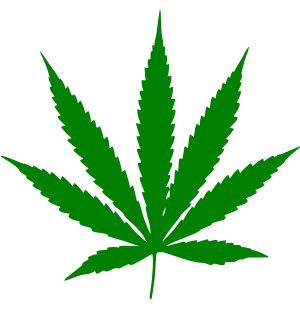The National Organization for the Reform of Marijuana Laws is an American non-profit organization based in Washington, DC whose aim is to move public opinion sufficiently to achieve the legalization of non-medical marijuana in the United States so that the responsible use of cannabis by adults is no longer subject to penalty. According to their website, NORML "supports the removal of all criminal penalties for the private possession and responsible use of marijuana by adults, including the cultivation for personal use, and the casual nonprofit transfers of small amounts", and "supports the development of a legally controlled market for cannabis". NORML and the NORML Foundation support both those fighting prosecution under marijuana laws and those working to legalize marijuana. Similar affiliated organizations operate under the NORML banner in other countries, among them NORML New Zealand, NORML Ireland, NORML Canada, NORML UK and NORML France.

The Marijuana Policy Project (MPP) is the largest organization working solely on marijuana policy reform in the United States in terms of its budget, number of members, and staff. Its stated aims are to: (1) increase public support for non-punitive, non-coercive marijuana policies; (2) identify and activate supporters of non-punitive, non-coercive marijuana policies; (3) change state laws to reduce or eliminate penalties for the medical and non-medical use of marijuana; and (4) gain influence in Congress. MPP advocates taxing and regulating the possession and sale of marijuana in a manner similar to alcohol, envisions a nation where marijuana education is honest and realistic, and believes treatment for problem marijuana users should be non-coercive and geared toward reducing harm.

The Oregon Medical Marijuana Act, a law in the U.S. state of Oregon, was established by Oregon Ballot Measure 67 in 1998, passing with 54.6% support. It modified state law to allow the cultivation, possession, and use of marijuana by doctor recommendation for patients with certain medical conditions. The Act does not affect federal law, which still prohibits the cultivation and possession of marijuana.

In the United States, the non-medical use of cannabis is decriminalized in 15 states, and legalized in another 11 states, as of June 2019. Decriminalization refers to a policy of reduced penalties for cannabis offenses, typically involving a civil penalty for possession of small amounts, instead of criminal prosecution or the threat of arrest. In jurisdictions without any penalties the policy is referred to as legalization, although the term decriminalization is sometimes broadly used for this purpose as well.

The legal history of cannabis in the United States pertains to the regulation of cannabis for medical, recreational, and industrial purposes in the United States. Increased restrictions and labeling of cannabis as a poison began in many states from 1906 onward, and outright prohibitions began in the 1920s. By the mid-1930s cannabis was regulated as a drug in every state, including 35 states that adopted the Uniform State Narcotic Drug Act. The first national regulation was the Marihuana Tax Act of 1937.
Drug liberalization is the process of eliminating or reducing drug prohibition laws. Variations of drug liberalization include: drug legalization, drug relegalization and drug decriminalization.

Cannabis in Oregon is legal for both medical and recreational use. In recent decades, the U.S. state of Oregon has had a number of legislative, legal, and cultural events surrounding use of cannabis. Oregon was the first state to decriminalize the possession of small amounts of cannabis, and among the first to authorize its use for medical purposes. An attempt to recriminalize possession of small amounts of cannabis was turned down by Oregon voters in 1997.

In the United States, the use of cannabis for medical purposes is legal in 33 states, four permanently inhabited U.S. territories, and the District of Columbia, as of January 2019. Fourteen other states have more restrictive laws limiting THC content, for the purpose of allowing access to products that are rich in cannabidiol (CBD), a non-psychoactive component of cannabis. There is considerable variation in medical cannabis laws from state to state, including how it is produced and distributed, how it can be consumed, and what medical conditions it can be used for.

Cannabis in California is legal for both medical and recreational use. In recent decades, the U.S. state of California has been at the forefront of reform efforts of the legality of cannabis in the United States, beginning in 1972 with the state's first ballot initiative attempting to legalize cannabis. Although Proposition 19 was unsuccessful, California would later become the first state to legalize medical cannabis with the passage of the Compassionate Use Act of 1996. In November 2016, California voters approved the Adult Use of Marijuana Act to legalize the recreational use of cannabis. The use, sale, and possession of cannabis over 0.3% THC in the United States remains illegal under federal law.
Initiative 1068 was a proposed initiative for the November 2010 Washington state general election that would have removed criminal penalties from the adult use, possession, and cultivation of marijuana in Washington. Sponsored by Vivian McPeak, Douglass Hiatt, Jeffrey Steinborn, Philip Dawdy, initiative I-1068 sought to legalize marijuana by removing marijuana offenses from the state's controlled substances act, but failed to gather enough signatures to qualify for the ballot.

Oregon Ballot Measure 80, also known as the Oregon Cannabis Tax Act, OCTA and Initiative-9, was an initiated state statute ballot measure on the November 6, 2012 general election ballot in Oregon. It would have allowed personal marijuana and hemp cultivation or use without a license and created a commission to regulate the sale of commercial marijuana. The act would also have set aside two percent of profits from cannabis sales to promote industrial hemp, biodiesel, fiber, protein and oil.

California Proposition 19 was a ballot initiative on the November 2, 2010 statewide ballot. It was defeated, with 53.5% of California voters voting "No" and 46.5% voting "Yes." If passed, it would have legalized various marijuana-related activities, allowed local governments to regulate these activities, permitted local governments to impose and collect marijuana-related fees and taxes, and authorized various criminal and civil penalties. In March 2010, it qualified to be on the November statewide ballot. The proposition required a simple majority in order to pass, and would have taken effect the day after the election. Yes on 19 was the official advocacy group for the initiative and California Public Safety Institute: No On Proposition 19 was the official opposition group.

In the United States, the use and possession of cannabis is illegal under federal law for any purpose, by way of the Controlled Substances Act of 1970. Under the CSA, cannabis is classified as a Schedule I substance, determined to have a high potential for abuse and no accepted medical use – thereby prohibiting even medical use of the drug. At the state level, however, policies regarding the medical and recreational use of cannabis vary greatly, and in many states conflict significantly with federal law.

The legal history of cannabis in the United States began with state-level prohibition in the early 20th century, with the first major federal limitations occurring in 1937. Starting with Oregon in 1973, individual states began to liberalize cannabis laws through decriminalization. In 1996, California became the first state to legalize medical cannabis, sparking a trend that spread to a majority of states by 2016. In 2012, Colorado and Washington became the first states to legalize cannabis for recreational use.
Alaska Measure 2 or the Alaska Marijuana Criminalization Initiative was a successful 1990 ballot measure in the U.S. state of Alaska; the initiative stated that it: "would change Alaska's laws by making all such possession of marijuana criminal, with possible penalties of up to 90 days in jail and/or up to a $1000 fine."
Wyoming has some of the strictest marijuana laws in the United States. Cannabis itself is not allowed for medical purposes, but a 2015 law allows limited use of non-psychoactive CBD oil.
Cannabis in North Dakota concerns the drug cannabis in North Dakota, United States, where cannabis was legalized for medical purposes in 2016 but remains illegal for recreational purposes. Possession of small recreational amounts is a misdemeanor crime. The cultivation of hemp is currently legal in North Dakota. In November 2018, the state's voters voted on recreational marijuana legalization, along with Michigan; the measure was rejected 59% to 41%.Two groups are putting marijuana legalization on the June 2020 Primary and the November 2020 elections.

The Adult Use of Marijuana Act (AUMA) was a 2016 voter initiative to legalize cannabis in California. The full name is the Control, Regulate and Tax Adult Use of Marijuana Act. The initiative passed with 57% voter approval and became law on November 9, 2016, leading to recreational cannabis sales in California by January 2018.
Cannabis in Missouri is illegal but decriminalized. Medical use was legalized in 2018 through a ballot initiative to amend the state constitution.
In the U.S. state of Ohio, cannabis is illegal for recreational use but decriminalized for possession of up to 100 grams. Medical use was legalized through a bill signed into law in June 2016, with the first legal sales occurring in January 2019.










